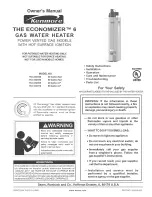
WL3 Technical Manual - Version 1, July 2014
14
15
1.
Remove packing straps and unpack unit and visually inspect for any damage.
(Report any defects to Waterlogic as soon as possible).
2.
Place the unit on a suitable work bench or leave on the floor for free standing
models.
3.
Open the top cover by removing the two screws that fix it in place.
4.
Visually inspect all electrical connections and power lead.
5.
Visually inspect all water connections.
6.
Remove the three screws on top of the Firewall Chamber and inspect the quartz
spiral for damage and re-assemble.
7.
Connect to a potable drinking water supply via a 1/4” John Guest tube,
the supply must be limited to 3 bar.
8.
Connect to a CO
2
gas regulator via a 1/4” John Guest tube and set to 3 bar.
9.
Connect the power cord to an appropriate power supply and the machine.
10.
Turn the CO
2
on and lift the yellow safety valve for 5 seconds.
11.
Replace the top cover and re-fit the screws.
12.
Once the power, water and CO
2
are all turned on the unit will auto fill the sparkling
water tank.
13.
Note that if the machine has a hot option, the hot tank must be filled before any
other tank.
14.
Select the hot + extra hot button until water flows clearly.
15.
Select the cold button until water flows clearly.
16.
After cold/hot has filled, turn on heater/compressor switch allow up to an hour
for the unit to heat and chill. Test water temperatures and ensure the water tastes
acceptable.
17.
Check all WL3 functions.
18.
Turn off power, water and CO
2
if a sparkling unit.
19.
Turn unit around and drain from rear drain valves if fitted.
20.
Clean and repack ready for dispatch.
21.
Waterlogic recommend that all units are fully electrically (PAT) tested on site by
the commissioning engineer as damage may have occurred during transit to the
unit’s final destination.
Installation Procedures
1.
Check and assemble the WL3 base cabinet if required to do so.
2.
Mount the WL3 Firewall on a firm, level surface so the machine cannot topple or
fall over. A 50mm air gap is required the whole way around the machine to allow for
sufficient ventilation. The WL3 must not be installed in direct sunlight, adjacent to a
heat source, or in an ambient room where the temperature is above 30°C or below
5°C.
3.
Level the machine using the adjustable feet if needed.
4.
It is advisable to have the power and water supply within a 2 metre range of
the machine, the isolation for the water and electricity should be easily accessible.
The supply of water must be from a potable source and the machine should not be
installed using an extension lead.
5.
Remove the top cover of the machine. If you are installing a freestanding machine
also remove the lower base cover. This is retained by two screws located under the
front edge at the bottom of the cover and two clips in the same location. Remove
the screws and push clips up to release it. Inspect all water and electrical and water
connections to make sure they have not come loose whilst in transit.
6.
If you are installing a carbonated machine then please follow this step, if not
proceed to step 7. Prepare the CO
2
cylinder first by removing the dust cap (if there
is one in place), then face the cylinder away from you and purge some of the gas for
two seconds to clear any dust or dirt from the nozzle prior to fitting the CO
2
pressure
regulator. Attach the CO
2
pressure regulator to the CO
2
cylinder and then attach to
the WL3 Firewall CO
2
‘IN’ bulkhead connector using 1/4” flexible pipe. Turn on the
CO
2
gas bottle. The pressure regulator should be pre-set at 45 PSI (3 bar). If the
pressure reading is higher or lower than 45 PSI, then please adjust it to the correct
setting. The CO
2
bottle should be secured inside the base cabinet, or secured within
a cabinet adjacent to the WL3 Firewall, so the cylinder cannot fall over.
7.
Remove the inline filter from the machine and attach a water feed directly into
the inlet side, attach another length of water pipe to the outlet side and direct this
into a bucket or a large container. Allow 10 litres of water to pass through the filter
clearing any carbon fines that may need to be flushed out. (This process may need
to be repeated).
Pre Delivery
Inspection Procedures (PDI)







































